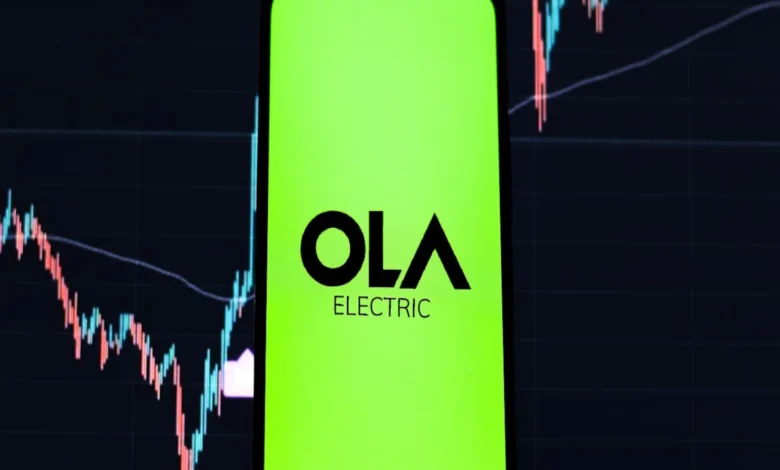Ola Electric Marks Flat Debut On The Stock Market Even As Investors Cashed In And Bhavish Aggarwal Doubles Fortune On Ola IPO; A Case Of “Inflated” Balloony?
Ola Electric's IPO made a lukewarm debut on August 9, 2024. The shares were listed at ₹76, which is exactly at the upper end of the IPO price band, indicating a flat opening. Despite the anticipation surrounding Ola Electric's entry into the public markets, the listing didn't see a significant premium, reflecting a more cautious investor sentiment. The company's IPO had already gained substantial interest, with the retail portion being oversubscribed 1.57 times during the subscription period. However, the lack of a substantial listing gain suggests that investors might be adopting a wait-and-see approach, particularly given the competitive market and the company's ongoing operational challenges.

Ola Electric Mobility’s much-anticipated IPO turned out to be a mixed bag, leaving many investors underwhelmed despite the company’s ambitious plans and the hype surrounding its entry into the stock market.
The shares were listed at ₹76 apiece on the NSE, right at the upper end of the IPO price band, marking a flat debut. On the BSE, the stock opened slightly lower at ₹75.99, reflecting the cautious sentiment among investors.
The muted listing stood in stark contrast to the broader market, where the BSE Sensex was trading 800 points higher, up 1%, and the NSE Nifty gained 278 points, or 1.15%.

Post-Listing Performance and Market Capitalization
Following the listing, Ola Electric’s stock did see some upward movement, rising as much as 4.82% to reach ₹79.66 on the BSE. This slight increase pushed the company’s market capitalization to ₹35,137 crore, but it was hardly the kind of surge that many had hoped for, especially given the significant interest during the IPO subscription phase.
The flat listing was not entirely unexpected, however, leading up to the IPO, the grey market premium (GMP) for Ola Electric’s shares had been volatile.
Initially, the company commanded a GMP of ₹16.5 per share in the unlisted market as of July 30, 2024. However, this premium gradually eroded, and by the time the IPO closed on August 6, 2024, the shares were available at a discount of ₹3 in the grey market.
IPO Subscription Details
Ola Electric’s ₹6,146 crore IPO was subscribed 4.45 times, primarily driven by strong demand from qualified institutional buyers (QIBs), who subscribed to their portion 5.53 times.
Retail investors were also enthusiastic, subscribing to their portion 4.05 times, while non-institutional investors subscribed 2.51 times.
The employee portion of the IPO was the most oversubscribed at 12.38 times. The company had allocated 75% of the issue for QIBs, 15% for non-institutional investors, and the remaining 10% for retail investors.

Bhavish Aggarwal’s Multi Crores Bagger
The IPO may have had a lackluster market debut, but it has significantly added to the fortunes of Bhavish Aggarwal, Ola Electric’s founder.
With the successful listing, Aggarwal’s net worth is expected to double to $2.3 billion, according to the Bloomberg Billionaires Index, adding $1.2 billion to his wealth.
However, the company has yet to comment on the implications of this IPO for its long-term strategy and Aggarwal’s future plans.
A Century On A Tough Pitch?
Ola Electric Mobility’s IPO has been described by its co-founder Bhavish Aggarwal as a “century on a tough pitch.”
While the IPO was successful in terms of subscriptions, with a 4.3 times oversubscription on the final day, the financial returns for investors have been a mixed bag.
The IPO, which was heavily subscribed, saw significant returns for early investors like Matrix Partners and Tiger Global.
Matrix Partners, which invested in Ola Electric at a weighted average price of ₹8.22 per share, achieved a 9.2X return on its investment by selling 37.27 lakh shares.
Similarly, Tiger Global made a 6.5X return, selling 63.61 lakh shares after initially investing ₹7.44 crore.
In contrast, other investors like SoftBank, Alpha Wave Venture, and MacRitchie Investments saw much more modest returns.
SoftBank, for instance, made a 1.5X return on its ₹122.55 crore investment by selling shares worth ₹181.31 crore.
Alpha Wave Venture earned a 1.22X return, while MacRitchie Investments and Ashna Advisors barely broke even with returns of 1.01X and 1.07X, respectively.

Disappointing Debut For Some
Not all investors benefited equally.
Tekne Private Ventures made a modest 32.8% gain on its investment, while Alpine Opportunity Fund faced a significant loss of 31.8%.
These figures underline the disparity in returns, particularly for those who bought in at a higher price. Tekne and Alpine had acquired shares at an average cost of ₹113.12 and ₹111.51, respectively, well above the IPO’s upper limit of ₹76 per share.
A Tough Valuation Battle
Ola Electric’s IPO valued the company at $4 billion, a 25% discount from its last funding round’s valuation of $5.4 billion in September 2023.
The reduction was partly due to investor pushback, which led the company to lower its valuation from an initially sought $10 billion. Despite these challenges, Bhavish Aggarwal framed the IPO as an opportunity for Indian investors to join Ola Electric’s growth story, albeit at a more “attractive” price.
Ola Electric plans to use the funds raised from the fresh equity issue, amounting to ₹5,500 crore, for various strategic initiatives.
These include capital expenditure for the subsidiary Ola Cell Technologies (OCT) to build the Ola Giga factory, repayment of debt incurred by subsidiary Ola Electric Technologies (OET), and investment in research and development.
The company also aims to fund organic growth initiatives and cover general corporate expenses.

The “So Far” Journey
Despite its growing revenue, Ola Electric remains unprofitable.
The company reported a net loss of ₹1,584.4 crore for FY 2023-24, an increase from ₹1,472 crore in the previous fiscal year.
However, revenue from operations saw a significant jump, growing 90.4% to ₹5,098 crore, up from ₹2,630.9 crore in FY 2022-23.
The company’s EBITDA loss also increased slightly to ₹1,267.6 crore in FY 2023-24, compared to ₹1,252.4 crore in the previous year.
A Quick Overview Of The Ola Electric IPO
Ola Electric’s public issue, which opened for retail subscription on August 2 and closed on August 6, garnered significant interest, particularly from qualified institutional buyers (QIBs).
The portion allocated to QIBs was subscribed 5.31 times, while retail investors’ quota saw a subscription of 3.92 times, and non-institutional investors (NIIs) subscribed 2.4 times.
However, the overall subscription of 4.27 times was relatively low when compared to other recent IPOs in the startup space. For instance, travel tech company ixigo’s public issue was oversubscribed by 98.34 times, coworking startup Awfis by 11.4 times, and insurtech unicorn Go Digit by 9.6 times.
Prashanth Tapse, Senior VP (Research) at Mehta Equities, pointed out that the lower-than-expected demand for Ola Electric’s IPO.
He attributed this potential discount to the company’s weak financials and the ongoing risk of negative net cash flows, which could impact its financial position post-listing.
Tapse advised that only risk-tolerant investors consider holding the stock for a minimum of two to three years, citing potential volatility in the short term despite a positive long-term outlook.
Ola Electric went public amid significant cash burn and uncertainty regarding its path to profitability.
InCred Equities expressed a cautiously optimistic view on the IPO but noted that quarterly volatility due to policy changes and delays in the EV cell plant could limit stock price gains.
Meanwhile, LKP Securities has given a ‘subscription’ rating for the public issue, albeit with a long-term perspective.
The Last Bit, While Ola Electric’s IPO has been framed as a win, particularly for early investors like Matrix Partners and Tiger Global, the broader market response and the performance of other investors indicate that the debut was not without its challenges.
Ola Electric’s IPO debut might not have lived up to the market’s high expectations, but it has still managed to secure a significant valuation and bolster investor confidence, at least in the short term.
As the company looks to the future, the real test will be in its ability to deliver on its ambitious plans and achieve profitability, and in sustaining this momentum as Ola Electric continues its journey as a public company.
For now, it seems that while the talk was big, the substance may take a bit longer to materialize.




